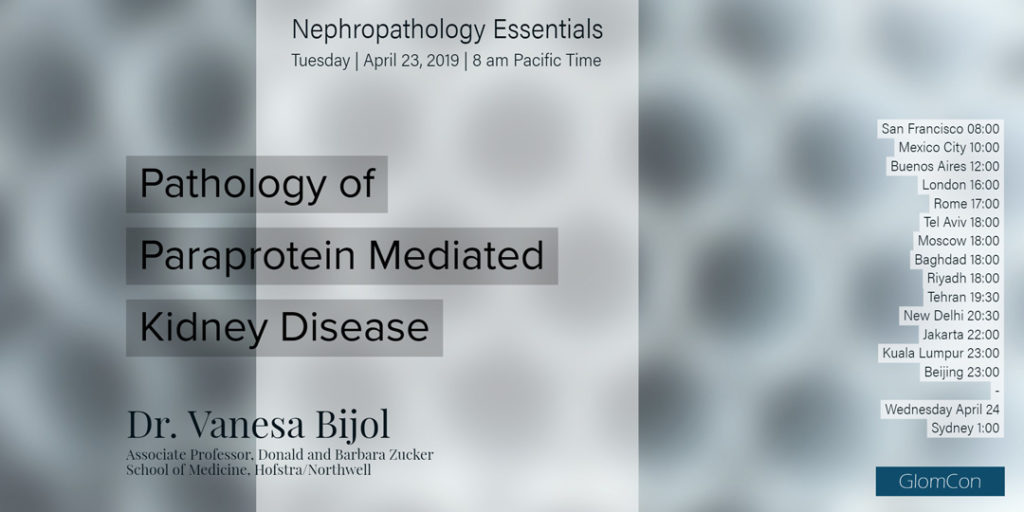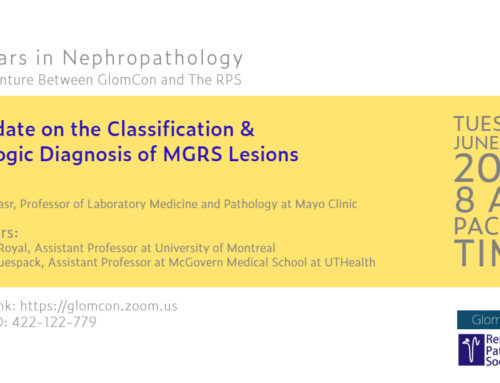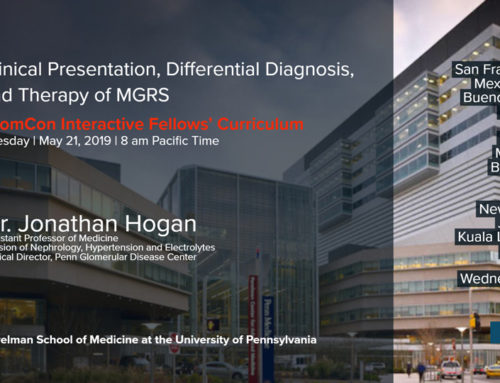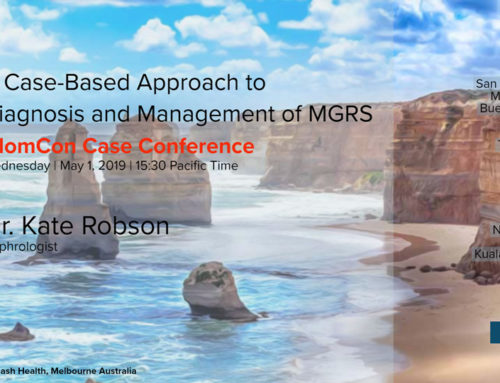NEPHROPATHOLOGY
Pathology of Paraprotein Mediated Kidney Disease
In this GlomCon Conference, Dr. Vanesa Bijol discussed the renal pathology of paraprotein mediated kidney disorders. This summary does not do justice to the image-focused review of tissue pathology and the interactive discussion. Nevertheless, below our Moderator’s Notes, based on her live presentation.


By Dr. Ali Poyan Mehr
Key Points:
Paraprotein related kidney disease:
• Can be mediated by any cell capable of producing immunoglobulins (e.g., plasma cells such as in myeloma or plasmacytoma, or B-cells such as in leukemias, lymphomas, Waldenström’s macroglobulinemia, etc.)
• Due to circulating paraproteins which can:
o Deposit in tissue
Amyloid: AL, AH, AHL, AA
Non-amyloid: Monoclonal immunoglobulin deposition disease
o Be filtered by glomerulus: (e.g., cast nephropathy, crystal storing nephropathy, etc.)
o Express “functional effects” (e.g., TMA, C3 GN associated with MGRS, etc.)
Examples:
AL Amyloidosis:
- Congo-red positive on light microscopy or “apple green” birefringent on polarized light.
- On silver stain ‘eye-lash” type appearance of GBM abnormalities may suggest amyloid.
- Light microscopy, however, has limited sensitivity, and many cases may ultimately be diagnosed by immunofluorescence studies for immunoglobulin light chains and heavy chains.
- Electron microscopy (randomly arranged non-branching microfibrils of 8-12 nm in diameter) has additional utility in diagnosis.
- Mass spectrometry (done in specialized labs such as Mayo Clinic) can also help characterize the nature of the deposits in cases where immunofluorescence does not provide answers.
- Predominantly lambda light chain (kappa-subtype is rare)
- In U.S. most common form of amyloid (90%) (in other countries AA amyloid more common due to infection etc.)
Other amyloid deposits:
AA Amyloid
- More common in other countries due to infection etc.
- Related to chronic inflammatory conditions e.g. chronic non-healing wounds, TB, Crohn’s disease, rheumatoid arthritis, hereditary syndromes such as familial Mediterranean fever and seen in drug users doing “skin popping” (njecting illicit drugs into the skin).
- Congo Red positive, characteristic fibrils on EM
- Negative for kappa/lambda light chains on IF
LECT2 Amyloidosis
- Predominantly reported in Hispanic populations
- Tends to have preferential interstitial involvement however can affect glomeruli and the vasculature as well
Monoclonal immunoglobulin deposition disease (MIDD):
- Light chain deposition disease (LCDD)
- Most common subtype
- LC only (most commonly Kappa)
- Deposits in glomeruli and tubules
- Heavy chain deposition disease (HCDD)
- HC only (most commonly Gamma)
- Deposits in glomeruli and tubules
- Light and heavy chain deposition disease
- LC&HC / entire Ig (most commonly IgG3 Kappa)
- Predominantly glomerular deposits
- Light microscopy (PAS, silver stain) shows nodular glomerulosclerosis (due to matrix expansion) in LCDD, HCDD
- Immunofluorescence (Kappa, Lambda, Ig subclasses, C1q, C3) important to distinguish the subtype of MIDD and differentiate from other diagnoses (e.g. immune complex diseases)
- MIDD is Congo-red negative (in contrast to amyloid)
- EM shows ‘dusty’/’peppered’ deposits along GBM and TBM in LCDD, HCDD
Proliferative glomerulonephritis with monoclonal immunoglobulin deposition (PGNMID):
Also referred to as “Nasr Glomerulopathy” – During the session contrasting views were presented and discussed on the terminology and classification of PGNMID. Some experts felt that PGNMID should be considered its own entity: It is sufficiently distinct in its clinical presentation and tissue pathology. Others noted that it is ultimately a variation in the tissue pattern of monoclonal immunoglobulin deposition disease, and should be listed under this category until further studies more clearly demonstrate it to be a distinct disease entity. A detailed and nuanced discussion was beyond the scope of the session. Reference to the original report on PGNMID is below (3). Those who wish to discuss this in further detail, please use our forum: https://forum.glomcon.org/
- Fanconi syndrome, crystal-storing tubulopathy, cast nephropathy, and others were deferred to be reviewed during a follow up session.
Selected references:



